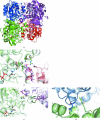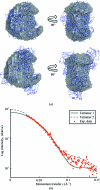X-ray crystal structure and small-angle X-ray scattering of sheep liver sorbitol dehydrogenase
- PMID: 21543846
- PMCID: PMC3087622
- DOI: 10.1107/S0907444911007815
X-ray crystal structure and small-angle X-ray scattering of sheep liver sorbitol dehydrogenase
Abstract
The X-ray crystal structure of sheep liver sorbitol dehydrogenase (slSDH) has been determined using the crystal structure of human sorbitol dehydrogenase (hSDH) as a molecular-replacement model. slSDH crystallized in space group I222 with one monomer in the asymmetric unit. A conserved tetramer that superposes well with that seen in hSDH (despite belonging to a different space group) and obeying the 222 crystal symmetry is seen in slSDH. An acetate molecule is bound in the active site, coordinating to the active-site zinc through a water molecule. Glycerol, a substrate of slSDH, also occupies the substrate-binding pocket together with the acetate designed by nature to fit large polyol substrates. The substrate-binding pocket is seen to be in close proximity to the tetramer interface, which explains the need for the structural integrity of the tetramer for enzyme activity. Small-angle X-ray scattering was also used to identify the quaternary structure of the tetramer of slSDH in solution.
Figures




Similar articles
-
Catalytic mechanism of Zn2+-dependent polyol dehydrogenases: kinetic comparison of sheep liver sorbitol dehydrogenase with wild-type and Glu154-->Cys forms of yeast xylitol dehydrogenase.Biochem J. 2007 Jun 15;404(3):421-9. doi: 10.1042/BJ20061384. Biochem J. 2007. PMID: 17343568 Free PMC article.
-
Crystal structure of sorbitol dehydrogenase.Chem Biol Interact. 2001 Jan 30;130-132(1-3):351-8. doi: 10.1016/s0009-2797(00)00260-x. Chem Biol Interact. 2001. PMID: 11306057
-
X-ray crystallographic and kinetic studies of human sorbitol dehydrogenase.Structure. 2003 Sep;11(9):1071-85. doi: 10.1016/s0969-2126(03)00167-9. Structure. 2003. PMID: 12962626
-
Sorbitol dehydrogenase: structure, function and ligand design.Curr Med Chem. 2004 Feb;11(4):465-76. doi: 10.2174/0929867043455927. Curr Med Chem. 2004. PMID: 14965227 Review.
-
Determination of protein oligomeric structure from small-angle X-ray scattering.Protein Sci. 2018 Apr;27(4):814-824. doi: 10.1002/pro.3376. Epub 2018 Feb 10. Protein Sci. 2018. PMID: 29352739 Free PMC article. Review.
Cited by
-
High-throughput biological small-angle X-ray scattering with a robotically loaded capillary cell.J Appl Crystallogr. 2012 Apr 1;45(Pt 2):213-223. doi: 10.1107/S0021889812000957. Epub 2012 Feb 9. J Appl Crystallogr. 2012. PMID: 22509071 Free PMC article.
-
New insights into the evolutionary history of plant sorbitol dehydrogenase.BMC Plant Biol. 2015 Apr 12;15:101. doi: 10.1186/s12870-015-0478-5. BMC Plant Biol. 2015. PMID: 25879735 Free PMC article.
-
Sugar alcohol degradation in Archaea: uptake and degradation of mannitol and sorbitol in Haloarcula hispanica.Extremophiles. 2024 Oct 28;28(3):48. doi: 10.1007/s00792-024-01365-z. Extremophiles. 2024. PMID: 39466404 Free PMC article.
-
Polyol specificity of recombinant Arabidopsis thaliana sorbitol dehydrogenase studied by enzyme kinetics and in silico modeling.Front Plant Sci. 2015 Feb 23;6:91. doi: 10.3389/fpls.2015.00091. eCollection 2015. Front Plant Sci. 2015. PMID: 25755662 Free PMC article.
References
Publication types
MeSH terms
Substances
Associated data
- Actions
Grants and funding
LinkOut - more resources
Full Text Sources

